Before we started our midterm project, we discussed the difference between “responsive” and “interactive” during the class. Therefore, I think my previous definition of “interaction” needs revising. Our group project – “doglar” – has a lot of functions that fulfill and respond to the dog’s needs. However, I reflect that it does not emphasize the continuous communication between the machine and the user or uses themselves – dog and the dog owner. Besides taking input, processing the information, and giving corresponding responses by the output that does something useful or entertaining, now I believe there is another key to making a project “interactive.” Therefore, every participant in the project equally stands to each other. An interactive project should also build a constant communication environment with the user or between users and learn new information from it. I think the concept of “interaction” to me is very relative to “Artificial Intelligence.”
Thinking from this point, my partner and I put our focus on making a continuous communication environment between users. An idea occurred to us that during Recitation 2 Assignment, we found it was fun and exciting to compete with another on who reaches the number 10 first by clicking buttons. However, we assess that it is not interactive enough since it lacks providing constant feedback for each other to continue the communication process when one user gives a response. Therefore, deriving from this basic framework, we planned to visualize the competing process by building a concrete user interface with fabrications and connect the two uses closely to each other throughout the playing process.
To achieve the goal of communication, we tried to align a few abstract variables to sensory information. Therefore, we designed a car race game. The place of the car in track represents Scores (times of clicking the button); the distance between the two cars and the melody represents the ranking; the sound and car crash position represents the result. With both sound and vision, the game is also accessible to certain disables. Keeping this goal in mind, we sketched a sample diagram. We initially built a straight track. Then we realize it would be better to design a circular track so that two users can face each other with constant focusing on the relative position of the two cars.
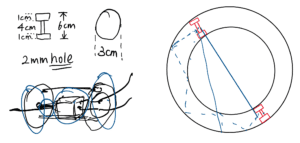
We referred to the sample circuit of the DC motor to drive the car. We laser cut the track, and 3D printed out the model of the car, where we insert the DC motor.
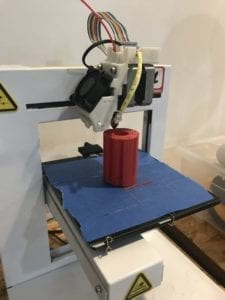
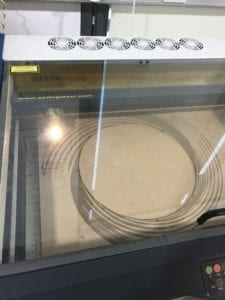
In the process of making the product, we encountered many obstacles, and we solved most of them accordingly. They include but not limited to: wired get messed with each other solved by setting up the track and adding another breadboard; cars do not go on the right direction solved by repositioning the car; cars do not go forward solved by stick crystal glue to the inner baffle; the surface of the wooden track is too smooth solved by adding a piece of cardboard to the car. During the user test session, since we had not had the sound working, we received a lot of helpful feedback that the user may felt a little lost after starting to play since they do not understand the ultimate ending of the game. This reflects that our consideration of the communication function is essential to the user’s experience of interacting with this project. We then get out of the unnecessary components, add sound to notify users about the process and made some necessary decorations: adding cardboard to support the button, setting the “start line” and so on so that the user may feel more friendly. Based on the final presentation, these improvements are successful since it arouses not only the users but also the audience’s intention to empathy on the game process.
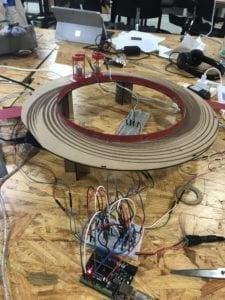
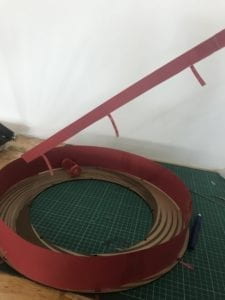
The goal of the project is to bring two users into communication by linking them together with an interactive game. I believe the process of improving our project reflects my new definition of “interaction” that addresses the constant communication between the two users. From visualize the ranking, making track circulate, and adding notification sound, users gradually feel the connection and tension between another player while playing the game. If it is only a game that tells me the final result, like the recitation assignment, the user may not feel the existence of another user in the process of the game. This is significant since the visualization and multisensory give constant feedbacks that link the two players together. Otherwise, if the user does not feel the sense of authentic communication, instead of calling it interactive, it could only be responsive.
Link to the Arduino code (Google Drive: NYU Access only): Changzhen devoted much to it!
Performance video:
- Test Version: Google Photo Sharing
- Improved (Final) Version: Google Photo Sharing